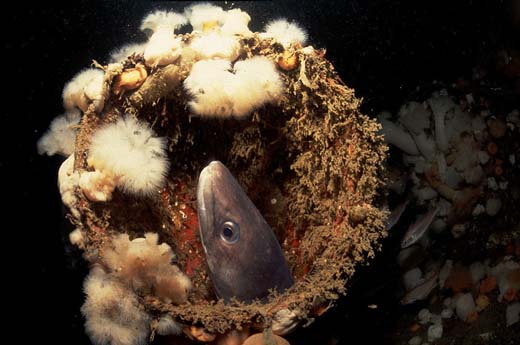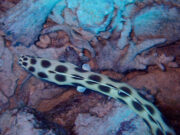The conger eel has the easiest-to-remember Latin name of them all: Conger conger. This massive fish can grow to almost 3 m (10 ft) long, the females often being bigger than the males.
Distinctive in shape, the conger lacks scales and has one long fin which stretches from behind the head, all along the body and round the tail to underneath its body. This fin is actually a fusion of the dorsal, tail and anal fins.
Conger eels are widespread. You find them in the Eastern Atlantic from Iceland to Senegal, in the Mediterranean and in the Black Sea. They like to hide in holes and crevices. At night they hunt fish and crustaceans like crabs and lobsters. In spite of this divers often see crustaceans sharing a hole with a conger. If you look closely at the photo above you can see squat lobster alongside the eel.

Congers breed only once in their lives, at between 5 and 15 years of age. They migrate to deep water to spawn – some sources say as deep as 4000 m – in one or more areas between Gibraltar and the Azores in the mid-Atlantic. After spawning they die, their larvae drifting back into coastal waters.
Evidence suggests that the eels are being over-fished, but they have not yet been assessed by the IUCN.
Conger eels are very strong and have been known to attack divers. However, they are docile unless provoked.
Further Reading
Great British Marine Animals by Paul Naylor
The Marine Life Information Network
Population structure and connectivity of the European conger eel
(Conger conger) across the north-eastern Atlantic and western
Mediterranean: integrating molecular and otolith elemental
approaches. Mar Biol (2012) 159:1509–1525, Alberto T. Correia et al.
Photos by Tim Nicholson, whose books and photos are available from http://www.photoboxgallery.com/timnicholson

















